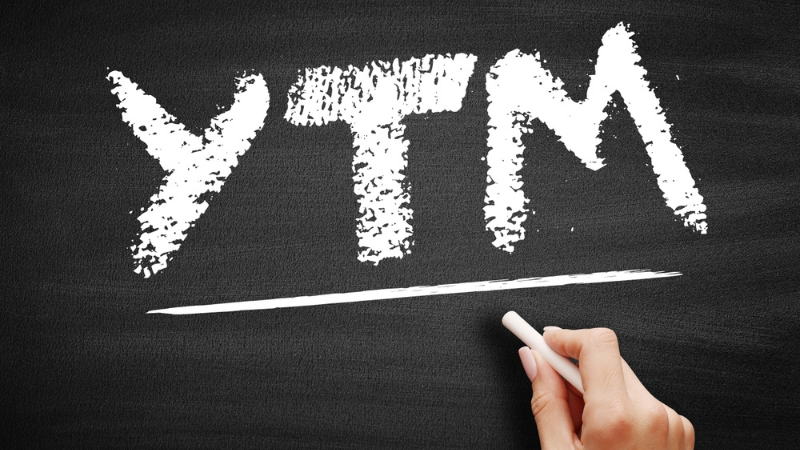
While analysing bonds one of the many terms that investors come across is the yield to maturity. It is one of the key parameters to understand the evaluation and comparison of bonds thereby making suitable investment decisions. But what is the meaning of yield to maturity and why is it relevant for bonds or debt mutual funds
Learn all about yield to maturity in this blog and how to calculate it.
Read More: Green bonds -What are they? Working and SEBI guidelines for Green Bonds
What is meant by Yield to Maturity?
Yield to Maturity (YTM) is a critical concept for investors in bonds or debt funds, as it provides a way to measure the potential annualized rate of return they can expect if they hold the investment until it matures. YTM takes into account several key factors, including the bond’s or debt fund’s face value, its purchase price, the time left until it matures, and its coupon rate (the fixed interest rate it pays).
YTM (Yield to Maturity) considers that all interest payments received while holding a bond or debt fund are reinvested at the same YTM rate. This assumption allows investors to better compare different bonds or debt funds and make informed decisions based on their investment objectives and risk tolerance.
Are you curious about – What does a bond with high YTM mean?
A bond with a high YTM indicates that it offers a higher potential return compared to bonds with lower YTMs. However, it also typically comes with higher risk, such as higher default risk or longer maturity periods.
What is the formula to calculate Yield to Maturity?
The formula to calculate Yield to Maturity (YTM) is given below.
YTM = [C + (F-P)/n] / [(F+P)/2]
Where
C = Annual coupon payment (in rupees)
F = Face value of the bond (in rupees)
P = Purchase price of the bond (in rupees)
n = Number of years to maturity
Let’s understand this with a simple example.
Suppose you are considering buying a 5-year bond with a face value of Rs. 1,000. The bond pays an annual coupon at the rate of 7%, and the current market price is Rs. 950. The YTM of this bond can be calculated as under.
YTM = [C + (F-P)/n] / [(F+P)/2]
YTM = [70+ (1000-950)/5] / [(1000+950)/2]
YTM = 80 / 975
YTM = 8.205
In the above example, if the bond is held till maturity, the YTM of the bond is approximately 8.21%. This means that you can expect an annualized return of approximately 7.18% on your investment, considering the coupon payments and the difference between the face value and the purchase price.
Are you curious about – What is the coupon rate?
The coupon rate refers to the fixed annual interest rate paid by a bond issuer to the bondholder. It is expressed as a percentage of the bond’s face value and determines the periodic interest payments the bondholder will receive.
Why is YTM important?
Yield to maturity can be significant for investors and bond issuers alike. It is one of the most important tools to evaluate bonds, especially in the case of bonds with varied tenures and coupon rates. This further aids the investors in making suitable effective investment decisions. On the other hand, yield to maturity allows then bond issuers to access and determine the optimal bond price for raising capital efficiently. Additionally, in the secondary market, YTM is instrumental in valuing bonds and guiding trading choices by evaluating if the bond is trading at a discount or premium. Its predictability, assuming the bond is held until maturity, makes it valuable for investors seeking a steady income stream.
Are you curious about – Why does the YTM of debt funds keep changing?
The YTM of debt funds keeps changing due to fluctuations in the underlying bond prices, interest rate movements, and changes in the composition of the fund’s portfolio.
What is the current yield and how is it different from YTM?
The terms current yield and yield to maturity are crucial in the bond market and the debt markets. To understand the difference and the importance of the two, let us first understand its meaning. We have seen the meaning of YTM above, now let’s come to the current yield.
Current yield is a straightforward measure that shows the annual income generated by a bond relative to its current market price. It is calculated by dividing the bond’s annual interest (coupon) payment by its current market price. The formula for the current yield is as follows
Current Yield = Annual Interest (Coupon) Payment / Current Market Price of the Bond ×100
This is the basic calculation of the annual yield that the investor can expect for the bonds held by them without considering factors like time to maturity.
The crucial difference between the current yield of a bond and the yield to maturity of a bond is the investment approach.
Current yield provides details of the immediate returns from the bond and therefore can be used in evaluating a bond for the short-term investment horizon. Yield to maturity on the other hand provides the bond’s potential return in case the bond is held till maturity. This benefits the investors in making long-term investment decisions based on their individual preferences of risk-return perception and their investment goals.
Are you curious about – What are the limitations of YTM?
The limitations of YTM include its assumptions of constant interest rates, no default risk, and reinvestment at the YTM rate. However, these assumptions may not hold true in the real world and can lead to potential discrepancies between estimated and actual returns on bonds. Additionally, YTM does not consider the impact of changes in market conditions or call options on bond returns.
Conclusion
YTM is one of the main parameters in the bond evaluation and provides an accurate assessment of the bond returns. However, it has a few limitations too that should also be considered while using it. This includes constant interest rates, no risk of issuer default, and reinvestment of all interest payments at a consistent rate. However, this may not be quite realistic and therefore, investors should exercise caution and consider these factors while interpreting YTM values for making informed investment decisions.


























